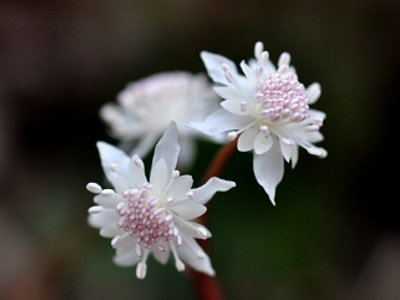Coptis
Coptis chinensis – rhizome
Coptis is especially recommended for the treatment of infective, congestive, and inflammatory states of the mucous membranes, gastrointestinal tract, and skin.
The go-to alternative to Golden Seal for it’s high berberine content and lesser cost. Golden Seal has a berberine content of (typically) 3%-4%, Coptis has a berberine content of 5%-8%.
Actions
Primary:
- Antibacterial, Antifungal
- Antidiarrhoeal
- Antiparasitic
- Antiulcer
Secondary:
- Anti-inflammatory, Antioxidant
- Cholagogue
- Mucous membrane tonic, Bitter tonic
Indications
- Bacterial infections
- Fungal infections
- Diarrhoea & dysentery
- Eye infections (topically)
- Parasitic infections (blastocystis, giardia, leishmania, entamoeba)
Contra-indications and Cautions
Contraindications
Safety in Pregnancy and Lactation: Berberine-containing plants are not recommended for use during pregnancy due to their potential for causing uterine contractions. The use of berberine-containing herbs in late pregnancy and during lactation is generally not advised.
Furthermore, the literature suggests that it is best to avoid berberine-containing plants in late pregnancy due to
an increased risk of kernicterus (bilirubin-induced brain dysfunction)121,126.
The incidence of kernicterus in premature Chinese infants with neonatal jaundice and glucose-6-phosphate
dehydrogenase (G6PD) deficiency has, in some cases, been reported to be associated with exposure to Coptis,
either by direct administration, transplacental absorption, or via breast milk (berberine can be transferred to
the infant via breastfeeding)120,122. It is thought that the berberine in Coptis displaces bilirubin from its protein
carrier, leading to an increase in unbound bilirubin and associated adverse consequences122. Although this safety
concern has been disputed in recent literature, 120,123.
Drug interactions
Concurrent use of berberine with metformin, glipizide, glimeprimide, rosiglitazone, and ezetimbe is considered safe.
Antibiotics – Coptis may have an additive or a synergistic effect when co-prescribed with pharmaceutical antibiotics. However, there have been inconsistent results in regards to tetracycline and berberine and thus simultaneous use is currently not recommended.
Bilirubin – Theoretically, Coptis may increase bilirubin levels in laboratory tests due to its berberine content. Berberine may cause an increase in total and unbound bilirubin concentrations as it has been shown to displace bilirubin from albumin in preliminary studies.
Cyclosporine – Due to its berberine content, Coptis may reduce the metabolism of cyclosporine (an immunosuppressant drug) and increase serum levels. This combination may allow a reduction of cyclosporine dosage under appropriate supervision. The mechanism for this interaction may be due to the inhibition of cytochrome P450 3A4 (CYP3A4) by berberine in the liver and/or small intestine.
Drugs metabolised by cytochrome P450 enzymes – Due to preliminary evidence showing that berberine potentially inhibits CYP450 enzymes, Coptis may theoretically increase the level of drugs metabolised by these enzymes.
Hypoglycaemic drugs – Due to the extensive antidiabetic effects of berberine, Coptis may enhance the effects of hypoglycaemic drugs. Monitoring of blood glucose levels is advised, as dosage adjustment may be required.
Statin drugs – Berberine may increase the effectiveness of statin drugs in lowering cholesterol as evidenced in both preclinical and clinical trials. In one study, the combined effect of simvastatin and berberine was over 30% greater than simvastatin alone.
Administration and Dosage
The analysis of contents below is a guide only, product specific data including expiry date is with the item in the shop.
Coptis chinensis 1:2. Each 1 ml contains 500mg of dry herb.
Liquid extract in 60% ethanol. Use 20 to 50 ml weekly.
Our clinic uses fluid extracts from Optimal Rx, Herbal Extract Company, Nutrition Care, Mediherb or Sunray Botanicals, in this order.
Notes
Coptis (Coptis chinensis) is a low growing plant that is indigenous to the mountainous regions of China. Coptis is also known as huang lian; literally translating to “yellow thread”, due to the intense golden colour of its rhizomes. The Coptis rhizome is primarily used in Traditional Chinese Medicine (TCM) to treat digestive, respiratory, and
infectious disorders, and is a rich source of the bioactive constituent berberine. Berberine gives Coptis its golden yellow colour.
Coptis is a valuable therapy in TCM, indicated to treat excess heat-related conditions, such as sore throat, high fever, dysentery, delirium, boils, burns, ulcers, eye inflammation, nosebleed, and blood in the urine, stool, phlegm, or vomit. Coptis is a potent bitter and cold remedy and is considered to be one of the more strongly acting heat-clearing herbal medicines.
Coptis plants were first recorded in the earliest Chinese Materia Medica, Sheng Nong’s Herbal Classic, in the Eastern Han dynasty (25 A.D. – 220 A.D.), and they have since been used in many Chinese herbal formulae for over 2,000 years. Coptis has been widely cultivated in China and its rhizomes are largely exported to other countries. In Korea and Japan, Coptis japonica is sometimes used as a substitute for Coptis chinensis.


